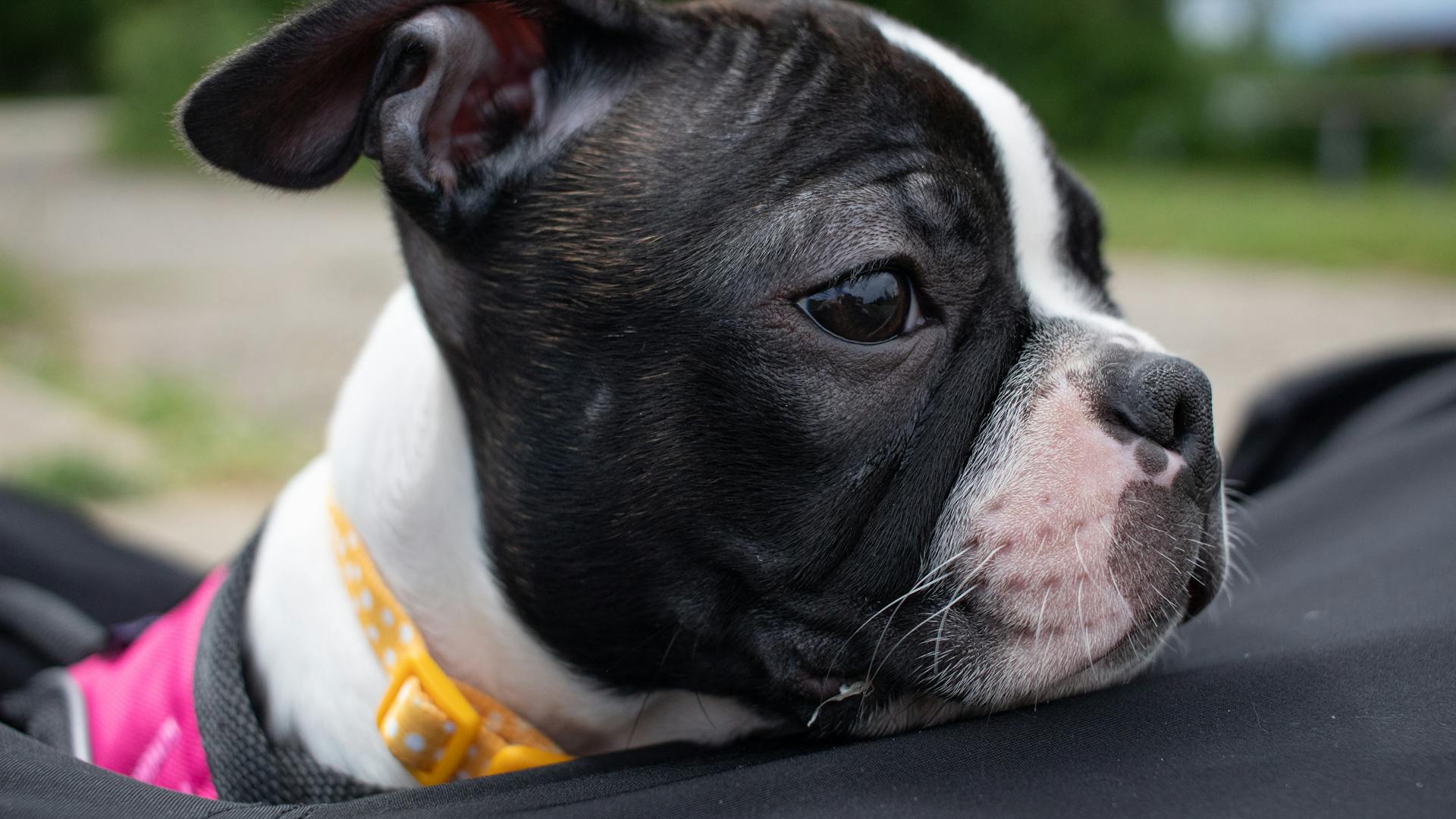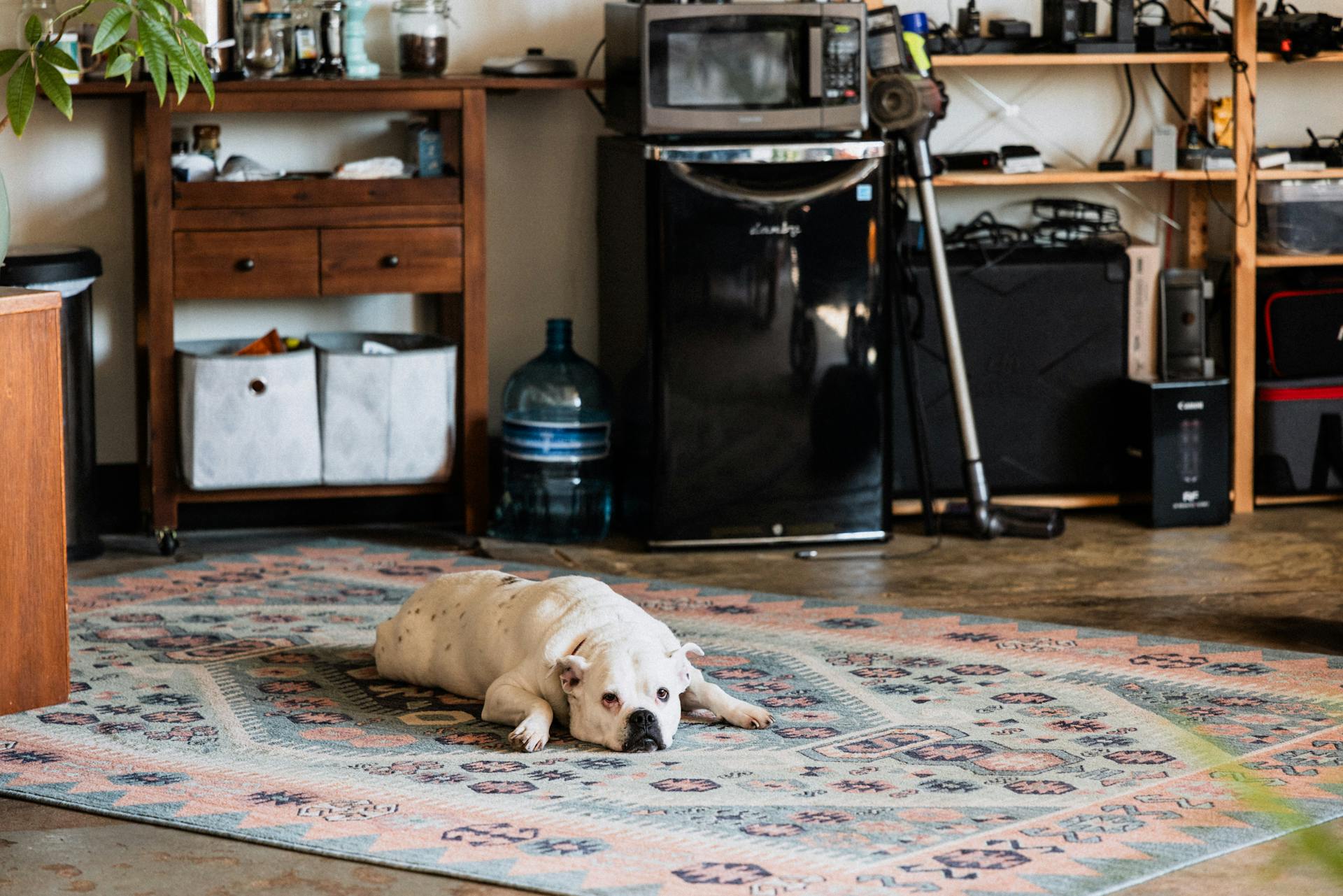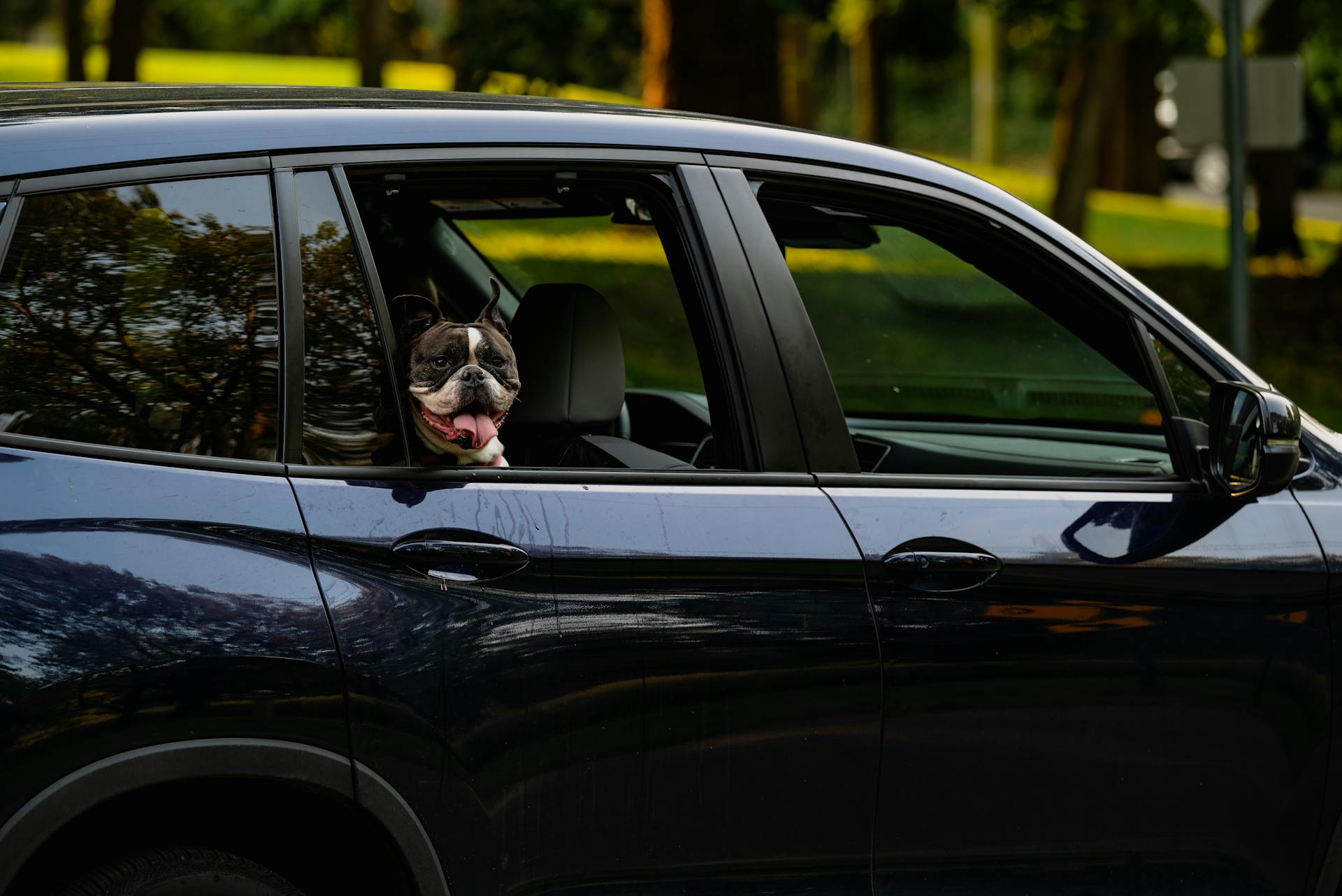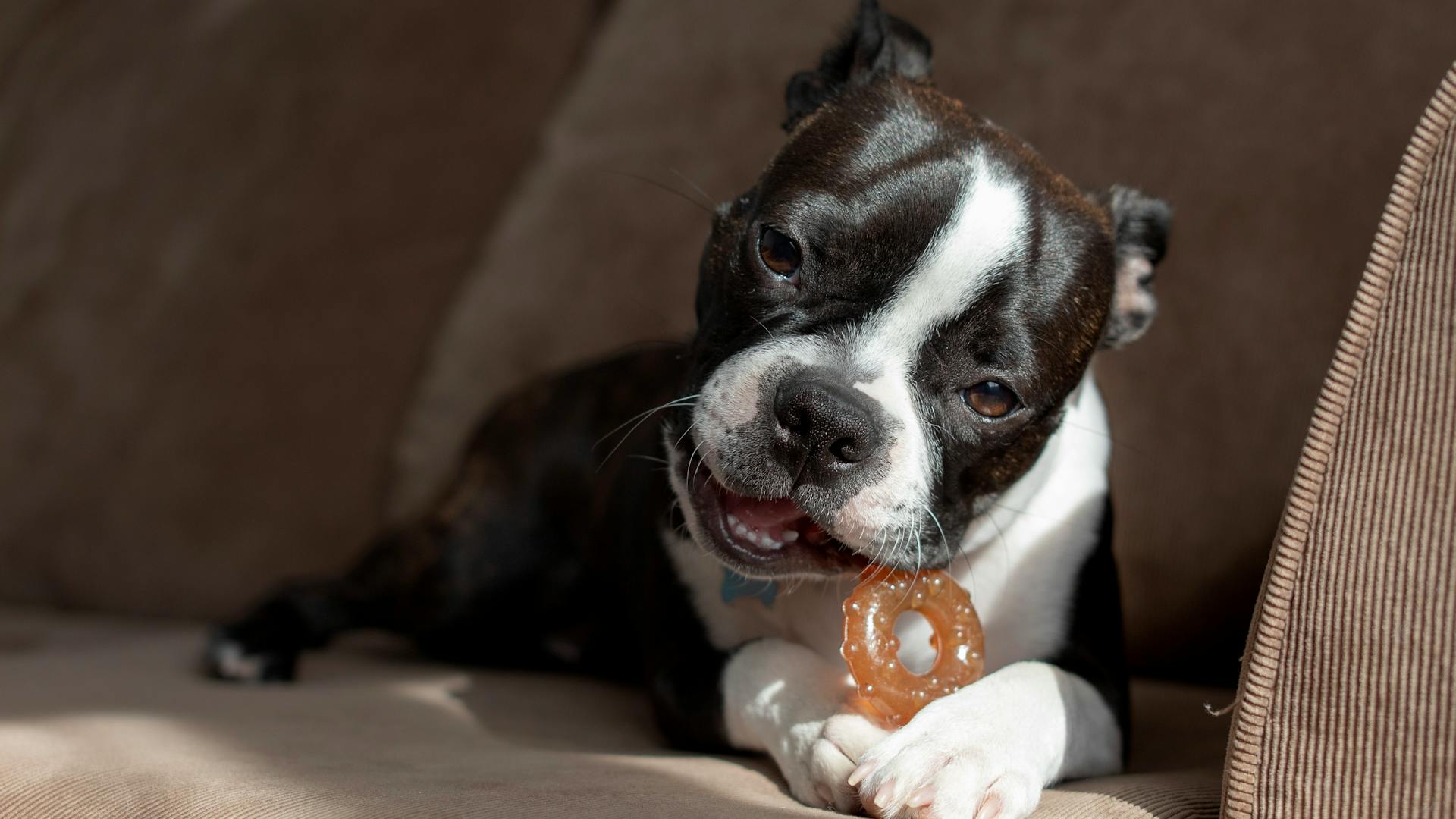
Boston Terriers are known for their short coats, but that doesn't mean they don't shed.
Boston Terriers typically shed lightly to moderately, with some owners reporting minimal shedding. They have a short, smooth coat that requires regular grooming to prevent matting and tangling.
While they don't shed as much as some other breeds, Boston Terriers still require regular brushing to remove loose hair and prevent shedding. This can be done with a soft-bristled brush or a grooming glove.
Regular grooming can help reduce the amount of loose hair and prevent shedding. It's also a great way to bond with your Boston Terrier and keep their coat looking its best.
Take a look at this: Boston Terrier Thinning Hair
Boston Terrier Shedding Basics
Boston Terriers are low to moderate shedders, with a single layer of short hair that sheds year-round. Their shedding level is comparable to French bulldogs and boxers.
You can expect minor to moderate shedding from your Boston Terrier, especially with regular brushing and a healthy diet. This will help keep their coat in good condition.
Boston Terriers have a smooth coat, which is one of the nine types of coats recognized by the American Kennel Club (AKC). They rank their shedding level as a two on a scale of one to five.
They shed less than dog breeds with a double coat, like golden retrievers, Labrador retrievers, and German shepherds. These breeds shed a moderate amount of hair year-round with two heavy shedding periods when the seasons change.
Boston Terriers don't have an undercoat, which means they won't blow their coat like double-coated breeds do. This makes their shedding easier to manage with occasional brushing and vacuuming.
Here's a rough estimate of the shedding levels of different breeds:
Boston Terriers shed a small amount of hair year-round, but it's still noticeable. With regular brushing and vacuuming, you can keep their shedding under control.
Genetic Causes of Hair Loss
Boston Terriers can be prone to hereditary skin problems that lead to baldness, a condition that affects some female Bostons around six months old.
This type of baldness starts around the ears and extends down the front of the neck and along the belly to the back legs.
The skin itself remains healthy and has no signs of infection, making it a unique and interesting phenomenon.
Female Bostons are more likely to develop this condition than males.
Brushing
Brushing is a crucial part of Boston terrier grooming. A soft-bristle brush is perfect for weekly grooming, removing loose hair and distributing natural oils throughout their coat.
Brushing your Boston terrier weekly will help minimize shedding. Even though their short hair doesn't get tangled or matted, they still benefit from regular grooming.
Boston terriers shed lightly when they have a healthy coat. If you notice excessive shedding, talk to your vet, as it can be a sign of fleas, mange, or another underlying health issue.
During seasonal changes, your Boston terrier will shed more and benefit from increased brushing. A hound mitt or grooming glove is ideal for daily brushing during spring and fall.
Related reading: How Big Will My Boston Terrier Get
A flexible, short-nubbed hound mitt or grooming glove stimulates the production of oils in your Boston terrier's skin. This is especially important during seasonal changes when they shed more.
Here's a quick guide to brushing your Boston terrier:
Managing Shedding
Boston terriers are a moderately shedding breed, but regular grooming can make a big difference in managing shed hair.
Twice weekly to weekly grooming is recommended to keep their coat in good condition and reduce shedding.
Their smooth coat is one of the nine types of coats recognized by the American Kennel Club (AKC), and they rank a two on a scale of one to five for shedding.
Boston terrier shedding is comparable to French bulldogs and boxers, which are also smooth-coated dogs.
Other smooth-coated breeds, including English bulldogs, bull terriers, Rottweilers, and pugs, will shed slightly more than a Boston terrier.
But all the smooth-coated breeds shed less than dog breeds with a double coat, like golden retrievers, Labrador retrievers, German shepherds, Australian shepherds, and huskies.
You might like: Boston Terrier Grooming
Here are some tips to manage Boston terrier shedding:
- Vacuum regularly: Vacuuming at least once a week will help reduce the amount of hair around your house.
- Invest in a robot vacuum: If vacuuming is not your idea of fun, use a robot vacuum to keep floors clean.
- Train your Boston to stay off the furniture: You can also train your dog to stay off furniture, which will keep fur confined to the floor.
- Set room boundaries: Minimize the reach of dog fur by teaching your dog to stay out of certain rooms.
- Keep lint rollers handy: With a lint roller by your door and one in your car, you can quickly clean dog fur off your clothes before you head out into the world.
Boston terriers have a single, short layer of fur, so you can expect minor to moderate shedding from your Boston Terrier.
With regular brushing, bathing, and a healthy diet, you might not even notice the occasional dog hair.
Their coats are low-shedding for most of the year, especially when compared with big shedders like the Labrador Retriever and the Akita.
Health and Allergies
Boston Terriers can suffer from allergies related to food and the environment, triggered by allergens like pollen, dust mites, mold, smoke, and wheat gluten.
These allergies can cause skin irritation, leading to excessive scratching and dander production. Dander is what causes allergic reactions in human allergy sufferers.
If your Boston Terrier has a skin allergy, it's essential to identify and address the allergen to reduce dander and alleviate symptoms.
You might like: Boston Terrier Dry Skin Home Remedies
Allergies
Boston Terriers are known to suffer from allergies related to both food and the environment. They can be triggered by various allergens like pollen, dust mites, mold, smoke, and wheat gluten.
If your Boston Terrier suffers from a skin allergy, they may scratch themselves more frequently, depositing more dander around your home. This dander is what causes allergic reactions in human allergy sufferers.
Some common allergens that can affect Boston Terriers include pollen, dust mites, and mold. These allergens can be found in the environment and can trigger allergic reactions.
If you suspect that your Boston Terrier has a food allergy, you may need to switch to a hypoallergenic diet. This can help to reduce the amount of dander and alleviate symptoms.
It's essential to be aware of the signs of allergies in Boston Terriers, such as excessive scratching, skin irritation, and digestive issues.
Explore further: Bumps on Boston Terrier Skin
When to Take My Dog to the Vet?
Your dog's shedding can be a sign of an underlying issue. If your dog is shedding more than expected, inspect the skin beneath his coat.
If you notice that his skin seems thick, greasy, scaly, red, or foul-smelling, it's time to schedule a consultation with your veterinarian. Your pup may need medication to calm and heal his skin.
If your dog is showing signs of excessive shedding, don't wait to take action. The sooner you address the issue, the better it is for your dog's overall health.
If this caught your attention, see: Boston Terrier Show Dogs
Are Hypoallergenic?
Boston terriers are not hypoallergenic, as they shed and release dander into the air and onto surfaces.
Dander is the main culprit behind allergic reactions, not dog fur itself. The Asthma and Allergy Foundation of America (AAFA) confirms this.
For people with moderate to severe pet allergies, any amount of shedding can trigger an allergic reaction. This includes Boston terriers, despite their relatively low-shedding coat.
Even people with very mild pet allergies may not be completely safe with a Boston terrier, as shedding can still spread allergens.
Discover more: Boston Terrier with Allergies
Breed Overview and Characteristics
Boston terriers are a small breed, typically standing between 15-17 inches tall and weighing between 12-25 pounds. They have a lifespan of 11-13 years.
Their small size makes them a great choice for families with kids, as they are generally good with children and other pets, including cats. They are also known to get along well with other dogs.
Boston terriers have a short, smooth coat that sheds significantly less than some other breeds. They do require occasional vacuuming to keep their coat clean, but their low-maintenance coats only need to be brushed once a week.
Their coat colors include brindle & white, black & white, and seal & white. Boston terriers are known for their eager, loving, and dependable temperament, making them a popular choice for many dog owners.
Here are some key characteristics of the Boston terrier breed:
- Height: 15–17 inches
- Weight: 12–25 lbs
- Lifespan: 11–13 years
- Breed Size: Small
- Colors: Brindle & white, black & white, seal & white
- Good With: Kids, other dogs, cats
- Temperament: Eager, loving, dependable
Featured Images: pexels.com


